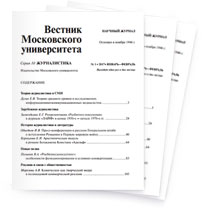Characteristic Features of the Approaches of Russian Media to Working with Content in Their Groups on Social Networks
Download paperSection: New Media
The importance of social networks for the dissemination of media materials greatly increased in the 2010s. As a matter of fact, social networks began to be listed as the main sources of traffic to media websites and as the primary sources of information for the audience. While in 2010 the traffic to media websites from social networks was around 1%, in 2014 it was already more than 10%, and in subsequent years it continued to grow, reaching 48% in 2017. Now, almost all media outlets in some way face the question of representing their content on social networks. The success of media itself depends on understanding which approaches to working with media content on social networks should be taken. The study sets a goal to answer the following questions: 1) did the media outlets increase their number of posts on social networks? 2) what are the key features of media outlets’ approaches to working with content on social networks? The analysis reveals some distinctive features such as the prevailing theme of accidents in the messages and the negative sentiment of the posts, the active use of media content (illustrations and videos), and the growing number of posts using videos and emojis. A large empirical base was used for the analysis, namely more than 200 thousand Russian media posts on social networks such as VKontakte, Odnoklassniki, Facebook* and Twitter*.
DOI: 10.30547/vestnik.journ.3.2022.87105References:
Caroline K. (2015) Do You Know What I Mean;:(: A Linguistic Study of the Understanding of Emoticons and Emojis in Text Messages. PhD thesis. Available at: http://www.diva-portal.org/smash/record.jsf?pid=diva2%3A783789&dswid=6586http://www.diva... (accessed: 01.01.2021).
Dunas D. V., Vartanov S. A. (2020) Emerging Digital Media Culture in Russia: Modeling the Media Consumption of Generation Z. Journal of Multicultural Discourses 15 (2): 186–203. DOI: 10.1080/17447143.2020.1751648
D’yachenko O. V. (2014) Rossiyskie SMI v sotsial’nykh setyakh Facebook i v «VKontakte»: praktiki vzaimodeystviya [Russian Media on Social Networks Facebook* and VKontakte: Interaction Practices]. Mediascope 4. (In Russian). Available at: http://www.mediascope.ru/1615 (accessed: 01.01.2021).
Kaminchenko D. I. (2020) Vzaimodeystvie sredstv massovoy informatsii i obshchestva: analiz informatsionnykh povestok dnya [Interaction Between Media and Society: An Analysis of News Agendas]. Voprosy zhurnalistiki, pedagogiki, yazykoznaniya 39 (4): 533–544. DOI: https://doi.org/10.18413/2712-7451-2020-39-4-533-544 (In Russian)
Kampes C. F., Brentel I. (2020) The German Online Media Market: Online-Born Information Offerings and Their Audiences – A Shift Towards Digital Inequalities? World of Media. Journal of Russian Media and Journalism Studies 4: 5–34. DOI: 10.30547/worldofmedia.4.2020.1
Kolesnichenko A. V. (2021) Zhurnalistika i blogosfera: zhanrovo-tematicheskie peresecheniya [Journalism and the Blogosphere: Genre-Thematic Intersections]. Vestn. Mosk. un-ta. Ser. 10: Zhurnalistika 10 (1): 52–75. DOI: 10.30547/vestnik.journ.1.2021.5275 (In Russian)
Kolesnichenko A. V., Vyrkovsky A. V., Galkina M. Y., Obraztsova et al. (2018) Transformation of Newsroom Work in the Digital Era. Russian Journal of Communication 11 (1): 1–16. DOI: 10.30547/worldofmedia.1.2018.1
Kruglova L. A., Bolotova E. A. (2020) Kontent radiostantsiy Business FM, «Vesti FM» i «Kommersant” FM» v sotsial’nykh media [Content of Radio Stations Business FM, Vesti FM and Kommersant FM in Social Media]. Vestn. Mosk. un-ta. Ser. 10: Zhurnalistika 10 (3). (In Russian). Available at: https://vestnik.journ.msu.ru/upload/iblock/40d/%D0%9A%D1%80%D1%83%D0%B3%D0%BB%D0%BE%D0%B2%D0%B0,%20%... (accessed: 01.01.2021). DOI: 10.30547/vestnik.journ.3.2020.5678
Shatskaya A. D. (2019) Proizvodstvo i «upakovka» kontenta televeshhateljami obshhego interesa i razvlekatel’noj tematiki v Internete [Content Production and “Packaging” by General Interest and Entertainment Television Broadcasters on the Internet]. Mediascope 3. (In Russian). Available at: http://www.mediascope.ru/2566 (accessed: 01.01.2021). DOI: 10.30547/mediascope.3.2019.5
Shatskaya A. D. (2020) Tekhnologii raboty vedushchikh rossiyskikh telekanalov s efirnym kontentom v internete: dis. ... kand. filol. nauk. [Technologies of Work of the Leading Russian TV Channels with on-Air Content on the Internet: PhD philol. sci. diss.] Moscow. Available at: https://istina.msu.ru/profile/Alexandra_Vankova/ (accessed: 01.01.2021).
Shchepilova G. G., Kruglova L. A. (2018) Telekanaly i sotsial’nye seti: spetsifika vzaimodeystviya [TV Channels and Social Networks: Characteristics of Interaction]. Vestn. Mosk. un-ta. Ser. 10: Zhurnalistika 10 (3). (In Russian). Available at: https://vestnik.journ.msu.ru/upload/iblock/08e/vest-03-18_sverka-3-16.pdf (accessed: 01.01.2021).
Sokolova D. V. (2017) Distributsiya novostnogo kontenta v messendzhere Telegram [Distribution of News Content in the Telegram Messenger]. Mediascope 4. (In Russian). Available at: http://www.mediascope.ru/2380 (accessed: 01.01.2021).
Tauch C., Kanjo E. (2016) The Roles of Emojis in Mobile Phone Notifications. In Ubicomp/ISWC’16 Adjunct. Available at: https://www.researchgate.net/publication/305489819_The_roles_of_Emojis_in_Mobile_Phone_Notifications (accessed: 01.09.2021). DOI: 10.1145/2968219.2968549.
Tian Y., Galery T., Dulcinati G., Molimpakis E. et al. (2017). Facebook Sentiment: Reactions and Emojis. In Proceedings of the Fifth International Workshop on Natural Language Processing for Social Media. DOI: 10.18653/v1/W17-1102. Available at: https://www.researchgate.net/publication/318740552_Facebook_sentiment_Reactions_and_Emojis (accessed: 01.09.2021).
Turnbull S., Jenkins S. J. (2016) Why Facebook* Reactions Are Good News for Evaluating Social Media Campaign. Journal of Direct, Data and Digital Marketing Practice 17 (3): 156–158. DOI: 10.1057/dddmp.2015.56.
Vartanova E.L. (2019) Teoriya media: otechestvennyy diskurs [Media Theory: the Russian Discourse]. Moscow: MSU Faculty of Journalism Publ. (In Russian)
Vartanova E. L. (2013) Postsovetskie transformatsii rossiyskikh SMI i zhurnalistiki [Post-Soviet Transformations of Russian Media and Journalism]. Moscow: MediaMir Publ. (In Russian)
To cite this article: Pershina E.D. (2022) Podkhod rossiyskikh SMI k rabote so svoim kontentom v sotsial'nykh setyakh [Characteristic Features of the Approaches of Russian Media to Working with Content in Their Groups on Social Networks]. Vestnik Moskovskogo Universiteta. Seriya 10. Zhurnalistika 3: 87–105. DOI: 10.30547/vestnik.journ.3.2022.87105






